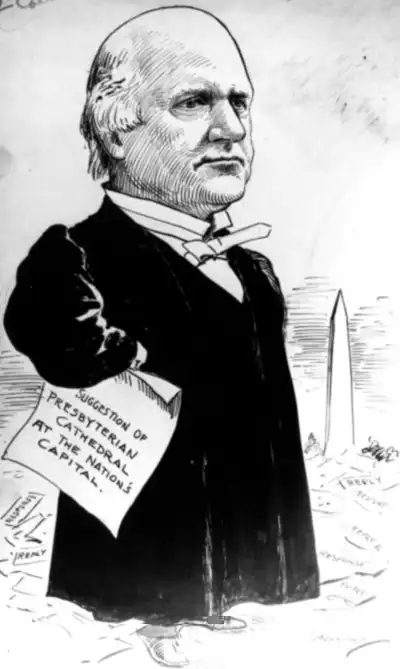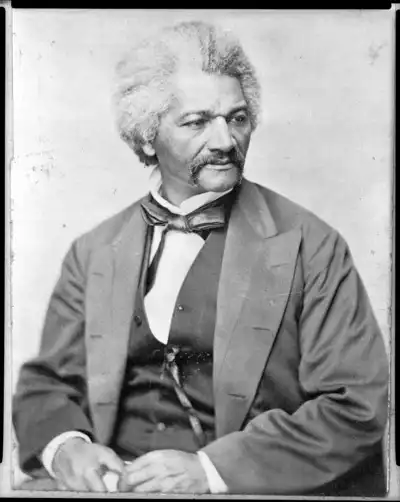
Harlan’s Presbyterian faith guided him throughout his life, and he spent decades on the board of Washington’s New York Avenue Presbyterian Church. His final mission – unfulfilled – was to build a new Presbyterian cathedral in the nation’s capital. | National Archives
Today, conservatives and liberals don’t agree on much when it comes to the Supreme Court. But as the newly remade Trump Court unveils its decisions in the most contentious cases of the just-ending term, the binary divisions are seeming suddenly less visible, and the ways in which judicial ideologies can overlap are more apparent. Rather than dividing along “conservative” and “liberal” lines, the Court was unanimous in a narrowly tailored ruling supporting Catholic Social Services, and unanimous in a case challenging the NCAA on antitrust grounds. It ruled 7-2 to uphold the Affordable Care Act.
The fact that there is one judicial figure that both sides proudly claim as their own offers a window into why it’s not always easy to break the court into “left” and “right” — and evidence that there may be more common ground than is widely believed.
It’s easy to see why liberals admire the Kentucky-born Harlan, who served from 1877 to 1911, since he laid the groundwork for several of the 20th Century’s progressive breakthroughs in civil rights and labor laws. At the height of the Gilded Age, he forcefully pushed back against colleagues who imposed their conservative political views onto the law. He was the only justice to decry the removal of rights for Black Americans — in cases involving civil rights, voting rights, integrated education and more. He also stood up for U.S. citizenship for Native Americans who left their tribal nations, the power of state legislatures to impose health and labor regulations and the government’s ability to break up corporate monopolies.
The fact that all these issues are seen as liberal landmarks makes it all the more surprising to realize that Harlan is deeply revered on the right. After lauding Harlan at his confirmation hearing, Gorsuch praised him copiously in his book about American exceptionalism and placed his portrait in his judicial chambers. It’s not the only image of Harlan to adorn the walls of the Supreme Court: A portrait of Harlan occupies a prominent place in the judicial conference room, where the justices decide cases. That’s thanks to Chief Justice John Roberts, another Harlan admirer. The conservative icon Antonin Scalia lauded Harlan’s Plessy dissent as “thoroughly originalist” — his ultimate compliment. And even Sen. Mitch McConnell, the architect of the Trump court, has a picture of Harlan, his fellow Kentuckian, in his office.
All of this would, of course, be a big surprise to most of the progressives of Harlan’s era and their 20th Century successors. Frederick Douglass called Harlan “a moral hero.” He was revered by the liberal crusader William Jennings Bryan. Harlan’s words inspired Thurgood Marshall and leaders of the modern civil rights movement, and his words, culled from his dissents of a half-century earlier, were featured in their legal arguments.

Frederick Douglass | Library of Congress
But as much of liberal America anxiously awaits a series of Supreme Court rulings that could unwind the progressive legal achievements of recent decades, the conservative embrace of Harlan is a reason for reconsideration. It’s a reminder that the Trump Court wasn’t really constructed by Trump, who expected (wrongly, it turned out) “his” justices to do his bidding after the Election. Gorsuch, Brett Kavanaugh and Amy Coney Barrett aren’t the judicial equivalents of Jeanine Pirro and Michael Cohen. They were part of a list of qualified jurists compiled by McConnell and force-fed to Trump as the price of conservative support. They come from a tradition that decries Roe v. Wade and other activist rulings by the court. But they are also intellectuals with their own legal touchstones, including Harlan.
Harlan’s own appointment to the court stirred much suspicion among Northern liberals, as he was a Southerner who had come from a slave-owning background and been slow to embrace the cause of abolition. He went on to become the court’s foremost defender of Black rights and economic protections. And if Harlan’s career proved anything, it’s that legal movements may be politically polarized, but the doctrines behind them are not.
History vindicated Harlan’s lonely dissents, and what both conservatives and liberals have admired over the years in Harlan is his willingness to stand against the tide, to face down his colleagues and popular opinion to do what was right. “He believes implicitly in the Constitution,” Justice David Brewer, who served with Harlan, said of him in 1902. “He goes to bed every night with one hand on the Constitution and the other on the Bible, and so sleeps the sweet sleep of justice and righteousness.”
Conservatives see in Harlan’s fidelity to the plain meaning of the Constitution a vindication of their view that legal protections must be enforced strictly as written, based on the original intent of the framers. When Harlan, in his Plessy dissent, eviscerated his colleagues for accepting the thin veil of separate-but-equal rather than granting Black people equal protection under the law, he was enforcing both the plain language of the 14th Amendment and the specific intent of those who wrote it. The other justices breezily went their own way. Likewise, by condemning the conservative justices of his era for imposing their economic views on the law — in striking down the Sherman Antitrust Act, for instance — he provided fodder for the current-day conservative critique of the liberal courts of the 1960s and ’70s for impressing their own values on the law.
Three of the Supreme Court’s picks came from the previous president. But you wouldn’t be able to guess it based on their recent decisions.
Liberals, on the other hand, respect Harlan as one of the few justices of his era who weighed his decisions based on their impact on average people. At a time when several justices took refuge in abstruse and airily philosophical decisions, Harlan’s opinions were replete with references to the real-world implications of the court’s actions. As a young politician, Harlan had watched the Supreme Court, with its unique power of finality, put the country on an inescapable path to war with its infamous Dred Scott ruling. Going beyond the question at hand — the formerly enslaved Dred Scott’s bid for freedom — the Supreme Court ruled that no Black people, free or enslaved, would ever have rights that white people must respect. That ruling simultaneously shocked constitutional scholars, inflamed Northern anti-slavery forces and left the political system with no recourse to solve the slavery issue but war.
For Harlan, struggling to keep his home state from joining the Confederacy, the Dred Scott ruling was a lifelong reminder of the grievous harms that emerge when the Supreme Court gets things wrong. Justice, he came to believe, had to be measured in several ways — for doctrinal consistency, yes; but also for how it would affect individuals on the ground and the future of the country.
When the Civil War ended, Harlan recognized that the nation couldn’t enforce minority rights with soldiers forever; that must become the unceasing obligation of the courts. He remained true to that mission even when his colleagues did not. And when the United States became a colonial power, assuming control of Puerto Rico, the Philippines and Hawaii, he saw in their unequal treatment a revival of the old cancer. His demand that the Constitution follow the flag — that all people under its power have equal rights — is the one part of his legacy that has yet to become a reality.
But while today’s liberals find a lot to admire in Harlan, it behooves them to acknowledge that the dissenting opinions they applaud include a heavy dose of originalism and textualism, the doctrines so often invoked by conservatives. A serious consideration of what the Constitution’s authors really meant was one of his tools for breaking out of the moral traps of the time. Conservatives, likewise, should understand that Harlan wasn’t wedded to their notion of “originalism” as the sole means of interpreting the law. When mandarins on the court pointed to obscure language in the Constitution to overturn a century of precedent and declare the income tax unconstitutional, Harlan sided with precedent: The income tax had become a widely accepted norm, no matter what the other justices managed to divine in the Constitution’s hazy language about direct and indirect taxation. In the infamous case of Lochner v. New York, he rightly rejected his fellow justices’ attempt to intuit a “right to contract” in the Constitution — but didn’t fully slam the door on judicial protection of rights not specifically mentioned in the Constitution, as some of today’s conservatives would do.